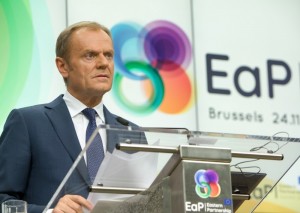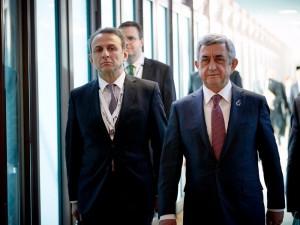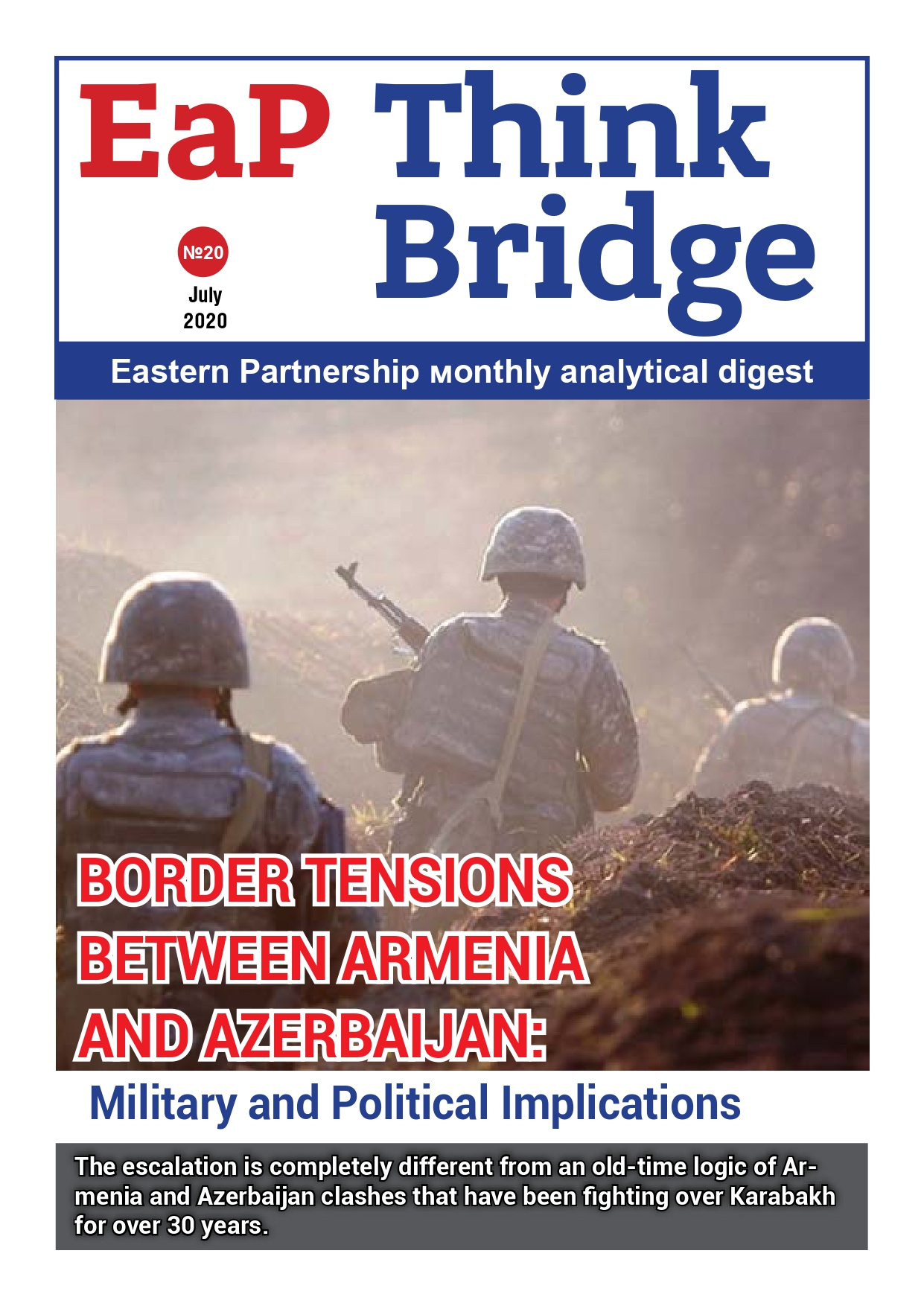Before the Eastern Partnership Summit took place in Brussels on 24, November every side had its own views, expectations and intentions. However, the Summit results demonstrated that the European Union was still capable of bringing quite a wide range of aspirations to the common denominator and keeping the initiative afloat even if it did not completely satisfy the needs of some participants.
Summit of compromise
The fifth Eastern Partnership Summit was supposed to answer to the main question: how will this EU initiative develop further on? However, more radical wording appeared just before the summit, asking if this initiative was to exist at all, and if it had any added value for the participants?
Brussels decided to keep the initiative, and that is why places at the heart of the current Summit a search for the ways to strengthen cooperation and achieve stronger economy, governance, connectivity and society. While evaluating the initiative overall as a successful one, the President of the European Council Donald Tusk highlighted the agreement to deliver the new political and economic objectives by 2020, especially reinforcing cooperation in a number of specific areas, such as small and medium-sized enterprises, digital economy, broadband investments, and investments in transport, energy and infrastructure projects. These priorities are suitable for all partner countries and do not provoke criticism of the third parties, such as Russia, at least within the interpretations of the Joint Declaration of the Summit.
Determining the membership perspective for the Eastern partners became a dilemma to the EU. It was clear that Brussels did not want to document it and left only a neutral phrase hat “the European Union acknowledges the European aspirations” of its associated countries and “welcomes their European choice”. It is difficult to reconcile these words with the EU statement, and personally one by Donald Tusk, regarding their “common future” and “the sovereign right of each of our European neighbors from the East to choose the level of ambition”. No answer was provided to the following question: what exactly the maximum level of these ambitions is and what the partners from the East can count on.
Determining the membership perspective for the Eastern partners became a dilemma to the EU
The Eastern Partnership regional stability is the main target for the initiative as the majority of the partner countries suffer from the military conflicts. Therefore, the EU Declaration yet again confirmed its support for the territorial integrity and sovereignty for all partners and called for resolving the conflicts in a peaceful way. This compromise points neither at the reasons for the conflicts, nor at the ways of their likely resolution, nor at the Russia’s destructive role, which, in one way or another, is present in all the instability zones.
However, the most important thing for the EU is that the positions of all partner countries are to be taken into account in order to satisfy the participants to the greatest extent possible and to keep their interest in the Eastern Partnership.
To Summit at «different speeds ”
At the current point the Eastern Partnership is a “different speed” initiative, where three countries (Ukraine, Georgia, and Moldova) are leading as they are associated states with a free trade zone and visa-free regime, Armenia has a Partnership Agreement, while Azerbaijan has some negotiations, and Belarus is being careful and limits itself to the bilateral and multilateral formats of the EU cooperation.
The aspirations regarding further cooperation are also on the different levels: from the EU membership to a simple mutually rewarding economic cooperation without a political component. This situation is without a doubt understood in Brussels, and therefore a different level of ambitions for the partner countries is declared, however, some attempts are made to avoid the Eastern Partnership fragmentation. That is exactly why the EU rejected the format “EaP PLUS” much discussed before the Summit and referred to the common OSCE and UN principles while highlighting stability, with no side acting against the latter.
Armenia is one of those few that achieved the desired result at the Eastern Partnership Summit in Brussels. The EU–Armenia Comprehensive and Enhanced Partnership Agreement was signed, which takes the relations to the next level of the enhanced political dialogue and economic cooperation. This will allow Yerevan to receive more of the European assistance while not deteriorating its relations with Moscow. Many experts suggested that Yerevan and Moscow view this agreement as a bridge between the EAEU and the EU. Even while giving his speech at the Summit, the President of Armenia Serzh Sargsian stated that: “many international counterparts of ours describe Armenia as a nation that brings various integration processes closer to each other“.

Following such a successful example Belarus, while being tied to Russia under a series of obligations within the frames of the Union State, Collective Security Treaty Organization (CSTO), the Eurasian Economic Union (EAEU), and the Eurasian Customs Union, started to talk about a new format of the relations with the EU. “Signing an agreement on partnership and cooperation is a matter of a short-term perspective»,– said the Foreign Minister of Belarus Vladimir Makey. And the most important aspiration is not to shape the way to consistent bonding with the EU but to get the economic dividends. Minsk was quick on the uptake and decided to use the Armenia’s successful experience, playing getting closer to the EU as “launching pragmatic cooperation between the EU and the Eurasian Economic Union“.
Azerbaijan had one big goal to achieve at the Summit: that is to raise the question of violating the territorial integrity of the country and the illegal deployment of the Armenian troops on the territory of Azerbaijan. It is exactly the reason why the President of Azerbaijan Ilham Aliyev did not attend the previous 2015 summit in Riga, and it is exactly why his entire speech at the Brussels Summit was devoted to this issue: “The territorial integrity of Azerbaijan has the same value as the territorial integrity of any other state, and it must be restored”. Even though Baku’s position was not entirely reflected in the Declaration, however, the Azerbaijani side was satisfied with the results of the summit as its final document supported the territorial integrity of the member states.
The most important thing for the EU is that the positions of all partner countries are to be taken into account in order to satisfy the participants to the greatest extent possible and to keep their interest in the Eastern Partnership
Georgia was not overly ambitious over the Eastern Partnership Summit and therefore had a positive reaction to its results. The Georgia’s Prime Minister Giorgi Kvirikashvili underlined that the Georgia’s progress and its successes were unanimously acknowledged. “It’s important that this format proved as a tool enabling Georgia to take such significant steps as the Association Agreement, FTA, and visa liberalization», – said the Head of Georgian Government. He also underlined that the European reforms continue to be held in Georgia, and stressed the importance of the time when the EU will be ready to include Georgia into its member states.
Moldova, just as Georgia, did not have any ambitious goals regarding the Summit. Its main task was to achieve continuous financing for its domestic reforms – in October the EU withheld 28 mln euros over the justice reform hold-up in Chisinau. Having received the EU’s credit of trust, Chisinau had a positive reaction following the Summit results.
As for Ukraine, it is obvious that it had the biggest demands to the Summit, even though the expectations were quite predictable. Before the Summit the Ukraine’s Minister of Foreign Affairs Pavlo Klimkin made a clear statement that no break-through political decisions should be expected as a result of the Summit, while dubbing the Eastern Partnership as a “box with tools”.
In short, the Ukrainian rdemands were as following: a potential EU membership; an investment plan for Ukraine; acknowledging Russia as an aggressor state; new formats for the countries having signed the Association Agreement.
Already in the course of the Summit the President of Ukraine Petro Poroshenko spoke about the Russia’s aggression and called for determining the membership perspectives and using Partnership potential to the greatest extent: “Ukraine counts on the so-called “four unions”: the Energy Union, the Digital Single Market, the Customs Union, and the association with the Schengen zone”. The European Union reactions to all Ukrainian offers included declaring support for its “European aspirations” and territorial integrity, reminders of the “partner countries participating in the European Energy Union creating ” and the “cooperation on the digital markets harmonizing”. Instead of an investment plan there was some sustainable development agenda. Ukraine did not get the results it wanted, and therefore will focus on developing the bilateral relations with the EU. Following the Summit Pavlo Klimkin tweeted that the “European future is the relations between Ukraine and the EU“.
EU replied to expectations with requiring reforms and “20 Deliverables for 2020“
The above-mentioned stability is being viewed by the European Union not only as an opportunity to counteract the hybrid threats, but also as a society development and creating the stable government systems by holding the domestic reforms in the partner countries. “Sustained and effective reform progress is a key to the continued success of the Eastern Partnership”,– states the Summit Declaration.

In order to provide an incentive for the partner countries’ governments, the European Union made it clear that the financial assistance is closely tied to the reforms: “The EU financial support to its partners will be conditioned by the concrete reform steps“. This is clearly in evidence in the Ukraine’s case, as it is struggling to receive the third 600 mln EU tranche since Ukraine has not fulfilled the EU requirements.
The EU’s financial instrument is a rather efficient stimulating agent and an indicator of the relations within the Eastern Partnership. In the course of the Summit it was announced that the EU has provided 5,4 bln of the financial aid to its partners since 2009. This factor is quite appealing to the partner countries including those actively involved in other economic organizations. It is obvious that the Eastern Partnership financial component will continue to be the factor tying together the partner countries moving forward with a different speed and the EU.
The security issues in the Eastern Partnership region, significant not only for Ukraine, but for the other initiative members as well, are also interpreted within the frames of the domestic reforms. The majority of the Ukrainian experts that took part in a Center for Global Studies “Strategy ХХІ” survey regarding the state capabilities to counteract the hybrid threats (being supported by the EU and the International Renaissance Foundation) named the reforms according to the EU standards to be. the main input in the stability and common security.
In order to provide an incentive for the partner countries’ governments, the European Union made it clear that the financial assistance is closely tied to the reforms
The Summit Declaration highlights “the EU’s strengthened role in conflict resolution” even “including the EU field presence in conflict regions, when appropriate“. This phrase was perceived in Ukraine as the EU’s readiness to send its mission to Donbas. However, the “20 Deliverables for 2020” plan does not include such aims. As for the security issues, it mostly draws attention to counteracting the organized crime and the hybrid threats, cyber security, strengthening cross-border cooperation and disaster prevention, response and crisis management as well. The importance of cooperation in the area of the Common Security and Defense Policy and the partners’ valuable contribution to the EU missions and operations was also highlighted.
The reforms in the partner countries were also included in the “20 Deliverables for 2020” plan, which, as states in the Summit Declaration, is, “delivering tangible results in a transparent and inclusive manner, as well as strengthening resilience“. This document became a practical guidebook for the more active cooperation in the Eastern Partnership multilateral format. Its analysis by the Ukrainian national platform of the Eastern Partnership Civil Society Forum points at the obviously realistic targets for 2020, at least for the majority of the countries. That is probably why the mentioned plan often has a remark: “for three countries”.
Even though in the course of the Eastern Partnership Summit not enough attention was paid to the transitional results of the plan which were drawn up to November, 2017, however, both the EU and the Eastern Partnership in general will have another opportunity to do a transitional evaluation of this document in 2019, before holding the next summit, and will probably correct the set targets.
Eastern Partnership is moving on
Therefore, the European Union managed to get to the level of perceiving the initiative as common for all partner states, and even to take into account the attitude of the third countries, with Russia being first and foremost, having stated that the Eastern Partnership “is not aimed against anyone”. Moreover, Belarus was inspired by signing the Agreement with Armenia to search for a format of negotiable relations with the EU. It is obvious that Moldova and Georgia will concentrate on the domestic reforms and further sectoral integration with the EU in the short-term perspective.
Ukraine, having stated that summit results were expected, decided to differentiate its bilateral relations with the EU and the Eastern Partnership as a format of a multilateral cooperation under the EU auspices. Ukraine may become the initiative leader when achieving 20 Eastern Partnership Deliverables as it has already fulfilled them partially. However, Kyiv needs to pay more attention to the EU recommendations, especially those concerning the domestic reforms and the European financial assistance, since such an approach will be clearly transferred to the European Fund for Sustainable Development.
The Eastern Partnership Civil Society Forum may play an important role both providing assistance to the partner countries trying to achieve their deliverables by 2020 and get closer to the EU, and searching for the regional cooperation mechanisms suitable for all countries.
Brussels should, without a doubt, maintain the level which will satisfy all sides in order for the Eastern Partnership to be efficient and viable in the future. However, the EU also has to increase the integration level for the initiative leaders and admit their possible membership in the perspective, no matter how distant this perspective might be as “more for more” principle is still relevant.



